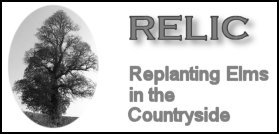In the 1970s Dutch elm disease swept through
the British countryside, killing the majority of elms, many
of which were centuries old. More than 20 million trees are known
to have been affected by the disease, which is carried by a bark
beetle.
Our first newsletter can be accessed directly from
here.
Why we are here...
A few years ago an elm was discovered near Pershore
that appeared to be immune to Dutch elm disease. Following
the discovery of the elm, John Clarke from Kemerton Conservation
Trust and Bob Hares, Royal Horticultural Society advisor to
Pershore college, successfully took cuttings. In February this
year the first saplings were planted at King George's Field,
Pershore.
The project was subsequently televised by the BBC
news programme - 'Midlands Today' early in March 2008. The
programme asked anyone who thought they might know the
whereabouts of a disease-resistant elm to contact Kemerton
Conservation Trust via their website. The four reports that were
broadcast produced an overwhelming response from the public, with
reports of disease-resistant elms being found in over 15
counties.
What we are doing...
One of the first tasks that the project faced was to
produce a framework that would allow the team to manage the
project effectively. The main requirements of the framework are
to:
-
Record and maintain key data received from
the public and other sources identifying potential
elms
-
To encourage a network of RELIC groups
within counties, taking in groups who have already
carried out research and grown some young trees, groups
who could take local cuttings to grow on so that locally
sourced plants are available. (Local, district and
regional councils, wildlife trusts, farmers' groups,
horticultural colleges and growers would be welcomed as
partners)
-
Co-ordinate with local 'knowledgeable
experts' who will validate sightings
-
Raise funds to encourage project continuity
without unnecessary hardship
-
Encourage local support for the project,
whereby cuttings taken can be grown-on and planted by
local councils, volunteers and possibly commercial
growers
-
Finally, record where young trees are
planted so that they can be monitored as they are
re-introduced into the countryside (it will not be
possible to determine if the young trees are
disease-resistant until they are approx 15-30 years
old)
A database has been developed to capture the
information received and will be used as the tool to allow the
above requirements to be managed effectively.











